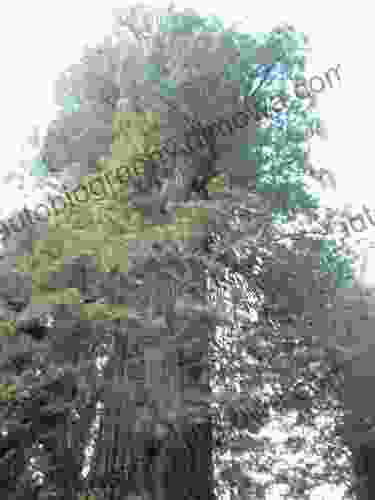The Brain As Archetypal Tree: A Journey into the Neurological Nature of Our Minds

The human brain is a complex and fascinating organ that has been the subject of scientific study for centuries. However, despite our advances in understanding, there is still much that we do not know about how the brain works and how it interacts with the rest of our body.
One way to gain a deeper understanding of the brain is to look at it from a different perspective. In her book _The Brain As Archetypal Tree_, Dr. Jill Bolte Taylor explores the connection between the brain and nature through the metaphor of the archetypal tree.
5 out of 5
| Language | : | English |
| File size | : | 544 KB |
| Text-to-Speech | : | Enabled |
| Enhanced typesetting | : | Enabled |
| Word Wise | : | Enabled |
| Print length | : | 14 pages |
| Lending | : | Enabled |
| X-Ray for textbooks | : | Enabled |
| Screen Reader | : | Supported |
Taylor argues that the brain is like a tree in many ways. Like a tree, the brain has a trunk, branches, leaves, and roots. The trunk of the brain is the brainstem, which is responsible for our basic life functions such as breathing, heart rate, and digestion. The branches of the brain are the cerebrum and cerebellum, which are responsible for higher-level functions such as thinking, language, and movement. The leaves of the brain are the neurons, which are the basic units of the brain. And the roots of the brain are the glial cells, which support the neurons and help to keep the brain healthy.
Taylor's book is a fascinating exploration of the connection between the brain and nature. She provides a wealth of insights into how the brain works and how it interacts with the rest of our body. _The Brain As Archetypal Tree_ is a must-read for anyone who is interested in the human brain and its connection to the natural world.
The Trunk of the Brain: The Brainstem
The brainstem is the trunk of the brain. It is responsible for our basic life functions such as breathing, heart rate, and digestion. The brainstem is also responsible for our sleep-wake cycle and our ability to move our bodies.
The brainstem is a vital part of the brain. Without it, we would not be able to survive. The brainstem is also the foundation for the rest of the brain. The cerebrum and cerebellum are built on top of the brainstem, and they rely on the brainstem for their function.
The Branches of the Brain: The Cerebrum and Cerebellum
The cerebrum is the largest part of the brain. It is responsible for our higher-level functions such as thinking, language, and movement. The cerebrum is also responsible for our personality, memories, and emotions.
The cerebellum is located at the back of the brain. It is responsible for our coordination and balance. The cerebellum also helps us to learn new motor skills.
The cerebrum and cerebellum are both important parts of the brain. They work together to allow us to function in the world.
The Leaves of the Brain: The Neurons
The neurons are the basic units of the brain. They are responsible for transmitting information throughout the brain. Neurons are also responsible for storing memories and emotions.
There are billions of neurons in the brain. They are all connected to each other in a complex network. This network allows the brain to process information and communicate with the rest of the body.
The Roots of the Brain: The Glial Cells
The glial cells are the support cells of the brain. They help to keep the neurons healthy and functioning properly. Glial cells also help to protect the brain from damage.
There are more glial cells in the brain than neurons. Glial cells are essential for the proper function of the brain.
The Brain As Archetypal Tree: A Journey into the Neurological Nature of Our Minds
Dr. Jill Bolte Taylor's book _The Brain As Archetypal Tree_ is a fascinating exploration of the connection between the brain and nature. She provides a wealth of insights into how the brain works and how it interacts with the rest of our body. _The Brain As Archetypal Tree_ is a must-read for anyone who is interested in the human brain and its connection to the natural world.
The brain is a complex and fascinating organ that is responsible for our thoughts, feelings, and actions. The brain is also a part of the natural world, and it is connected to the rest of our body in a profound way.
Dr. Jill Bolte Taylor's book _The Brain As Archetypal Tree_ is a beautiful and insightful exploration of the connection between the brain and nature. Taylor's book is a must-read for anyone who is interested in the human brain and its connection to the natural world.
5 out of 5
| Language | : | English |
| File size | : | 544 KB |
| Text-to-Speech | : | Enabled |
| Enhanced typesetting | : | Enabled |
| Word Wise | : | Enabled |
| Print length | : | 14 pages |
| Lending | : | Enabled |
| X-Ray for textbooks | : | Enabled |
| Screen Reader | : | Supported |
Do you want to contribute by writing guest posts on this blog?
Please contact us and send us a resume of previous articles that you have written.
 Book
Book Novel
Novel Page
Page Chapter
Chapter Text
Text Story
Story Genre
Genre Reader
Reader Library
Library Paperback
Paperback E-book
E-book Magazine
Magazine Newspaper
Newspaper Paragraph
Paragraph Sentence
Sentence Bookmark
Bookmark Shelf
Shelf Glossary
Glossary Bibliography
Bibliography Foreword
Foreword Preface
Preface Synopsis
Synopsis Annotation
Annotation Footnote
Footnote Manuscript
Manuscript Scroll
Scroll Codex
Codex Tome
Tome Bestseller
Bestseller Classics
Classics Library card
Library card Narrative
Narrative Biography
Biography Autobiography
Autobiography Memoir
Memoir Reference
Reference Encyclopedia
Encyclopedia Alex Gough
Alex Gough Michelle Madow
Michelle Madow Ray James
Ray James Alan Whitworth
Alan Whitworth Scotty Stevenson
Scotty Stevenson Alisha Gaddis
Alisha Gaddis Katherine Tuider
Katherine Tuider Andrew Rowen
Andrew Rowen Kindle Edition
Kindle Edition Amalie Howard
Amalie Howard Sherri Renee
Sherri Renee Bonnie Hopson
Bonnie Hopson I D Ansell
I D Ansell Hankie Vogel
Hankie Vogel Manuel Ayala
Manuel Ayala James S Aber
James S Aber Katharina Hagena
Katharina Hagena Seema Somani
Seema Somani Zan Romanoff
Zan Romanoff Anna Harrison
Anna Harrison
Light bulbAdvertise smarter! Our strategic ad space ensures maximum exposure. Reserve your spot today!
 Ernest ClineFollow ·16.8k
Ernest ClineFollow ·16.8k Sammy PowellFollow ·4.4k
Sammy PowellFollow ·4.4k Davion PowellFollow ·6.2k
Davion PowellFollow ·6.2k Charles ReedFollow ·11.8k
Charles ReedFollow ·11.8k Sam CarterFollow ·13.8k
Sam CarterFollow ·13.8k Dalton FosterFollow ·9.4k
Dalton FosterFollow ·9.4k Clark CampbellFollow ·15.6k
Clark CampbellFollow ·15.6k James HayesFollow ·19.9k
James HayesFollow ·19.9k

 Cruz Simmons
Cruz SimmonsUnlock the Secrets of Effortless Inline Skating with...
Discover the Ultimate Guide to Mastering...

 Richard Simmons
Richard SimmonsThe Novel of Joan of Arc: A Timeless Tale of Courage and...
A Journey Through...

 David Foster Wallace
David Foster WallaceMaster the Art of Skateboarding: Unveiling "The 100 Rules...
Get ready to...

 Jimmy Butler
Jimmy ButlerMishaps and Mayhem from Around the Corner and Across the...
Life is full of surprises, and not all of...

 Victor Hugo
Victor HugoPromised Land Alexander Iron: A Journey of Hope,...
Alexander Iron's...
5 out of 5
| Language | : | English |
| File size | : | 544 KB |
| Text-to-Speech | : | Enabled |
| Enhanced typesetting | : | Enabled |
| Word Wise | : | Enabled |
| Print length | : | 14 pages |
| Lending | : | Enabled |
| X-Ray for textbooks | : | Enabled |
| Screen Reader | : | Supported |














